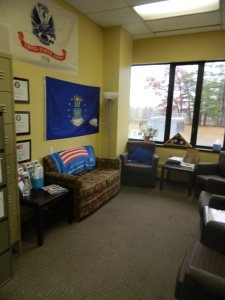
 Article & Photos by Jacqueline Bennett newsandviewsjb.com
Article & Photos by Jacqueline Bennett newsandviewsjb.com
A “For Sale” sign dominates the corner lot where Veterans of Foreign Wars Anderson Shea Post 2046 building has stood since the 1940’s in Manchester, Connecticut.
The VFW has troubles. It has fallen into disrepair and cannot come up with money to maintain the building, according to newspaper reports. But the troubles run deeper. Reflecting a national trend, membership is declining, down by 200 members from more than 500 to 300 in the last five years, according to the Hartford Courant. For at least a decade, similar stories have been told from California to Minnesota and now Connecticut.
Speculation is that the ranks of these folks who faced down Russian Communism and the Third Reich are aging and their younger counterparts are not interested in the VFW. In 2004 the Napa Valley Register published a piece about the “diminishing ranks” at the Calistoga VFW. Only seven Calistoga veterans of World War II had turned out for their regular meeting in the days before Veterans Day, reported editor John Waters, Jr.
“The farther we get from the actual event, the fewer and fewer the number of survivors,” Waters quoted the post Quartermaster as saying, “It’s really just a natural progression. Veterans of the Vietnam war and the Gulf war, and now Iraq, all have their various organization so we’re seeing a natural thinning of the ranks.”
In 2014, “Military 1 (star)” published an article titled, “4 reasons why the VFW is losing its battle for members”. First said author Lydia Davey, a veteran of the war in Afghanistan, is lack of relevance to younger generations. She particularly pointed to Millennials, who prefer to “engage with the world in meaningful ways.” Despite effective policy-making efforts by the VFW, the author contended the organization has not communicated well “more tangible aspects of social responsibility and activism”. Second, “the headache of bloated hierarchy; third, “an unwelcoming vibe”; and fourth, “dated recruiting practices”.
And, a news broadcast out of Minnesota documented the closing of a VFW post there. The story spoke of an overall loss of 800,000 members from VFWs in the last 20 years.
On a practical level, societal changes such as increasingly stringent DUI laws may be keeping patrons out of the VFW bars. The canteens – or bars, are considered a main source of revenue, it was noted in the Courant.
Old war stories told in dark, dreary halls that often house VFWs simply may not appeal to younger veterans who have other outlets in the community to find a reprieve. At Manchester Community College veterans say they appreciate the camaraderie they have at the Veterans’ OASIS, a small lounge with a couch, chairs, television, computers and a wealth of information about programs to assist veterans. On this Veterans Day 2015, a plate filled with peanut butter kiss cookies decorated with American flags sat on a table here for visitors to enjoy. And they cited other reasons for not being part of the VFW. In fact, the closing of the Manchester VFW was news to some here.
“I served during the Vietnam war but not in the war, I was in Europe. When I got out I didn’t think I was eligible to join, ” explained Dana O’Neill.
Shirley H. of Coventry is an Air Force veteran. She said she enlisted in May 1980 and served until October 2010.
“I’m a lifetime member of the VFW,” said Shirley H., a member of the Manchester post. Nevertheless, she is not an active participant. Activities generally held at night presented a conflict for her and other obligations she had. Although she had heard about breakfasts put on every other weekend at the post, she said she had a hard time getting information about scheduling.
A couple younger veterans who stopped in the Veterans OASIS shared their thoughts. Victor, who served in the Marines said he would not be put off by socializing with older veterans but was never approached about joining. Sombath, an Army veteran, added he is happy to support other veterans but is not interested in joining an organization.
Roots of the VFW can be traced back to 1899, after the Spanish-American War and Philippine Insurrection from 1899-1902, when returning veterans banded together to secure rights and benefits.
“Many arrived home wounded or sick. There was no medical care or veterans’ pensions for them and they were left to care for themselves,” it is stated on the VFW website.
By 1915 memberships grew to 5,000 and by 1936 it had reached 200,000. The VFW website puts its current membership with auxiliaries at 1.7 million and estimates their posts members have given 8.6 million hours of volunteerism and raised $3 million in scholarship and savings bonds for students. The VFW was “instrumental” it states in establishing the Veterans Administration, creating the GI Bill for the 20th Century, developing a national cemetery system, fighting for compensation for Vietnam veterans exposed to Agent Orange and veterans dealing with Gulf War syndrome, developing the GI Bill for the 21st Century with expanded educational benefits for American active duty service members and members of the Guard and Reserves fighting in Iraq and Afghanistan and development of VA medical centers and construction of war memorials.
So it seems much more is at stake than the vanishing of dimly lit halls where old soldiers can raise a glass to battles of the past.
Go to http://www.vfw.org/join for information about becoming a member of the VFW.
Tagged: Jacqueline Bennett, VFW declining


As a member of both AmLegion and VFW, it is now time to consolidate the 2. However, knowing both organizations, there will be a battle or shaking of walking canes to figure out to see who is in charge. Folks, combine, adapt, overcome.